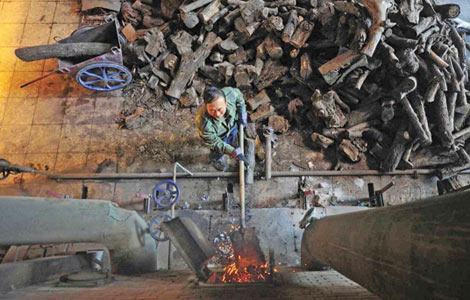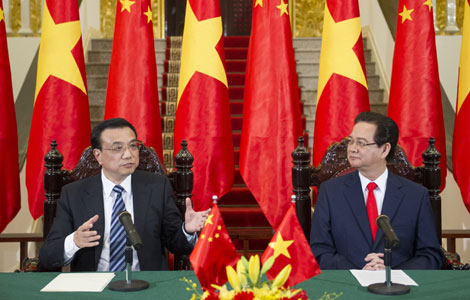China to lead the third industrial revolution: expert
Updated: 2013-10-14 13:36
By Xie Chuanjiao and Ma Weixin (chinadaily.com.cn)
|
||||||||
China is hoping to take the lead in the Third Industrial Revolution, according to Jeremy Rifkin, world-renowned economic and social theorist and the author of The Third Industrial Revolution, at a recent symposium held in Qingdao, China.
Jeremy Rifkin said the Third Industrial Revolution is about merging internet technology and renewable energies to create a new intelligent infrastructure that achieves high efficiency and productivity and near-zero marginal costs.
He said the establishment of a Third Industrial Revolution infrastructure will create thousands of new businesses and millions of jobs and lay the basis for a sustainable global economy in the 21st century.
"China will lead the Third Industrial Revolution, at least I hope so. If China does not do it, who will?" Jeremy Rifkin told China Daily at the sidelines of the event.
He said China has abundant renewable resources to produce new energies, including wind and solar power. Moreover, the concept of sustainable growth is written into the cultural DNA of the Chinese nation. "The Confucius philosophy has been advocating the harmonious relationship between mankind and nature for thousands of years, and it still prevails in China today," he said.
He recognizes that the leaders of China have paid great attention to green development and have even written it into the party constitution amendment last November.
Moreover, the technology for creating a green economy is available in the market now; the rest just rides on the mind-set. As long as China is determined to embrace the change, instead of being scared of it, it will succeed in transitioning the economy into a Third Industrial Revolution," he said.
He said China has deep responsibility in the 21st century to provide the leadership for a biosphere world, so that everyone can live in harmony with the rest of nature.
He suggested the government build a road map with targets and plans for 5 years, 10 years and 15 years to gradually advance the Third Industrial Revolution, just like the EU's 2020, 2030 and 2050 roadmaps. The government should also make clear rules, regulations, codes, standards and new laws to enhance the implementation of these plans.
He said new buildings and infrastructure should all be built with renewable energy solutions and be connected to the "Internet of Things". In addition, advanced manufacturing should embrace 3D printing — the customized manufacturing of products—which will reduce material and logistic costs with the possibility of huge energy savings.
"If these new technologies are not applied in the new construction, they are just copying the old development model. I hope China will not follow into the sunset of the western nation's second industrial revolution, but rather, lead into the sunrise of the Third Industrial Revolution," he said.
Mr. Rifkin also said the Chinese dream of a decent "quality of life" will help the Chinese people succeed in harmonizing their economic development with nature, allowing them to create an ecological civilization and lead the world into a new era of sustainable development.
Five pillars of the Third Industrial Revolution
The five pillars of the Third Industrial Revolution, as described by Jeremy Rifkin in his book The Third Industrial Revolution are:
(1) shifting to renewable energy;
(2) transforming the building stock of every continent into micro–power plants to collect renewable energies on-site;
(3) deploying hydrogen and other storage technologies in every building and throughout the infrastructure to store intermittent energies;
(4) using Internet technology to transform the power grid of every continent into an energy internet that acts just like the Internet (when millions of buildings are generating a small amount of renewable energy locally, on-site, they can sell surplus green electricity back to the grid and share it with their continental neighbors); and
(5) transitioning the transport fleet to electric plug-in and fuel cell vehicles that can buy and sell green electricity on a smart, continental, interactive power grid.

 Senate leads hunt for shutdown and debt deal
Senate leads hunt for shutdown and debt deal
 Chinese education for Thai students
Chinese education for Thai students
 Rioting erupts in Moscow
Rioting erupts in Moscow
 Djokovic retains Shanghai Masters title
Djokovic retains Shanghai Masters title
 Working group to discuss sea issues
Working group to discuss sea issues
 Draft regulation raises fines for polluters
Draft regulation raises fines for polluters
 Other measures for the capital to become green
Other measures for the capital to become green
 Colombian takes wingsuit crown
Colombian takes wingsuit crown
Most Viewed
Editor's Picks

|

|

|

|

|

|
Today's Top News
Going green can make good money sense
90 killed in stampede in central India
Senate leader 'confident' fiscal crisis can be averted
China's Sept CPI rose 3.1%
No new findings over Arafat's death: official
Detained US citizen dies in Egypt
Investment week kicks off in Dallas
Chinese firm joins UK airport enterprise
US Weekly

|

|







